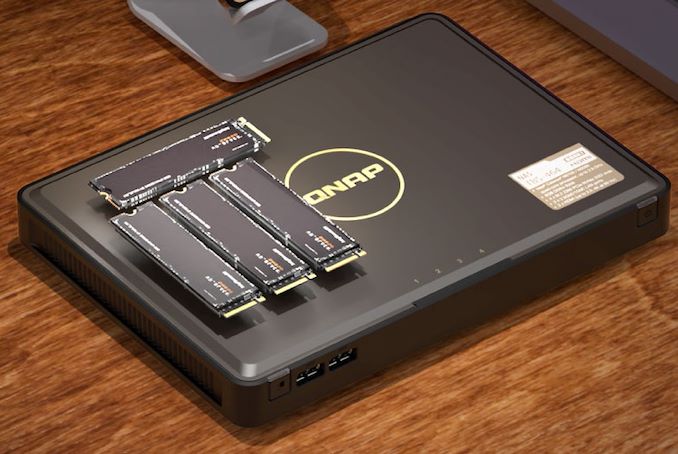
Over the previous couple of years, the developments within the industrial off-the-shelf (COTS) network-attached storage (NAS) market have largely been on the software program entrance – bringing in additional business-oriented worth additions and higher assist for containers and digital machines. Now we have had {hardware} updates by way of processor decisions and inclusion of M.2 SSD slots (primarily for SSD caching), however they haven’t been revolutionary adjustments.
At CES 2023, QNAP revealed plans for 2 totally different NAS models – the all-flash TBS-574X (primarily based on the Intel Alder Lake-P platform), and the ML-focused TS-AI642 (primarily based on the Rockchip RK3588 app processor). Whereas QNAP solely supplied a teaser of the capabilities, there are a few factors value speaking about to get an thought of the place the COTS NAS market is headed in direction of within the close to future.
Hybrid Processors
Community-Hooked up storage models have usually been primarily based on both server platforms within the SMB / SME house or single-board laptop (SBC) platforms within the house shopper / SOHO house. Historically, each platforms have eschewed huge.LITTLE / hybrid processors for a wide range of causes. Within the x86 house, we noticed hybrid processors coming into the mainstream market not too long ago with Intel's Alder Lake household. Within the ARM world, huge.LITTLE has been round for a comparatively longer time. Nonetheless, server workloads are usually unsuitable for that kind of structure. With no credible use-case for such processors, additionally it is unlikely that servers will go that route. Nonetheless, SBCs are a special case, and now we have seen a lot of software processors adopting the massive.LITTLE technique getting utilized in that market section.
Each the all-flash TBS-574X and the AI NAS TS-AI642 are primarily based on hybrid processors. The TBS-574X makes use of the Intel Core i3-1220P (Alder Lake-P) in a 2P + 8E configuration. The TS-AI642 relies on the Rockchip RK3588 [ PDF ], with 4x Cortex-A76 and 4x Cortex-A55 fabricated in Samsung's 8LPP course of.
QNAP isn’t any stranger to advertising Atom-based NAS models with 2.5 GbE assist – their latest Jasper Lake-based tower NAS line-up has proved extraordinarily widespread for SOHO / SMB use-cases. The Gracemont cores within the Core i3-1220P are going to be a step-up in efficiency, and the addition of two efficiency cores can simply assist with person expertise associated to options extra amenable to be used of their Core-based models.
NAS models have develop into highly effective sufficient to maneuver above and past their fundamental file serving / backup goal performance. The QTS purposes curated by QNAP assist in offering well-integrated worth additions. Among the hottest ones allow container assist in addition to the flexibility to run digital machines. Because the vary of workloads run on the NAS concurrently begin to range, hybrid processors can pitch in to enhance efficiency whereas sustaining energy effectivity.
On the AI NAS entrance, the Rockchip RK3588 has processor cores highly effective sufficient for a multi-bay NAS. Nonetheless, QNAP is placing extra give attention to the neural community accelerator blocks (the SoC has 6 TOPS of NN inference efficiency), permitting the NAS to be marketed to heavy customers of their surveillance and 'AI' apps corresponding to QVR Face (for face recognition in surveillance movies), QVR Sensible Search (for occasion looking in surveillance movies), and QuMagie (for simply listed photograph albums with 'AI' performance).
E1.S Scorching-Swappable SSDs
QNAP's first NASbook – an all-flash NAS utilizing M.2 SSDs – was launched into the market final yr. The TBS-464 stays a novel product out there, however goes towards the NAS idea of hot-swappable drives.

QNAP's First-Era NASbook – the TBS-464
On the time of its introduction, there was no trade customary for hot-swappable NVMe flash drives appropriate for the NASbook's form-factor. U.2 and U.3 drive slots with hot-swapping capabilities did exist in rackmount models meant for enterprises and datacenters. So, QNAP's NASbook was launched with out hot-swapping assist. In the meantime, the trade was consolidating in direction of E1.S and E1.L as customary form-factors for hot-swappable NVMe storage.

(L to R) E1.S 5.9mm (courtesy of SMART Modular Programs); E1.S Symmetric Enclosure (courtesy of Intel); E1.S (courtesy of KIOXIA)
QNAP's 2023 NASbook – the TBS-574X – would be the first QNAP NAS to assist E1.S hot-swappable SSDs (as much as 15mm in thickness). So as to improve drive compatibility, QNAP can even be bundling M.2 adapters connected to every drive bay. It will enable end-users to make use of M.2 SSDs within the NASbook whereas market availability of E1.S SSDs expands.
Specs Abstract
The TBS-574X makes use of the Intel Core i3-1220P (2P + 8E – 10C/12T) and consists of 16GB of DDR4 RAM. Reminiscence growth assist shouldn’t be clear as but (It’s seemingly that these are DDR4 SO-DIMMs). There are 5 drive bays, and the NAS appears to be working QTS primarily based on QNAP's mannequin naming). The NASbook additionally sports activities 2.5 GbE and 10 GbE ports, two USB4 ports (seemingly Thunderbolt 4 sans certification, as QNAP claims 40 Gbps assist, and ADL-P helps it natively), and 4K HDMI output. The NASbook additionally helps video transcoding with the built-in GPU within the Core i3-1220P. QNAP is primarily concentrating on collaborative video modifying use-cases with the TBS-574X.
The TS-AI642 makes use of the RockChip RK3588 (4x CA-76 + 4x CA-55) app processor. The RAM specs weren’t supplied – SoC specs point out LPDDR4, however now we have reached out to QNAP for the precise quantity . There are six drive bays. That is once more fascinating, for the reason that SoC natively provides solely as much as 3 SATA ports. So, QNAP is both utilizing a port multiplier or a separate SATA controller linked to the PCIe lanes for this goal. The SoC's native community assist is restricted to twin GbE ports, however QNAP is together with 2.5 GbE in addition to a PCIe Gen 3 slot for 10 GbE growth. These are additionally certain to take up the restricted variety of PCIe lanes within the processor (which is 4x PCIe 3.0, configurable as 1 x4, or 2 x2, or 4 x1). General, the {hardware} is sort of fascinating by way of how QNAP will be capable of handle efficiency expectations with the SoC's capabilities. With a give attention to surveillance deployments and cloud storage integration, the efficiency could also be ok even with port multipliers.
Concluding Remarks
General, QNAP's teaser of their two upcoming desktop NAS merchandise has supplied us with insights into the place the NAS marketplace for SOHOs / SMBs is headed within the close to future. QNAP has by no means shied away from exploring new {hardware} choices, not like Synology, QSAN, Terramaster, and the like. Whereas we’re very bullish on E1.S assist and hybrid processors in desktop NAS models, the enchantment of the RockChip-based AI NAS could rely closely on its worth to capabilities / efficiency facet.
Know-how






